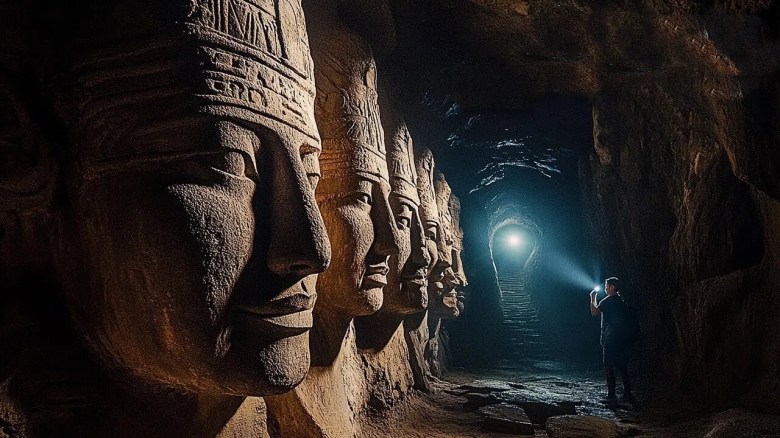Shocking! Scientists discover a 6,000-year-old civilization inside a hidden cave.

In an unprecedented discovery, an international team of archaeologists has uncovered what appears to be an unknown civilization more than 6,000 years old hidden within a secret cave in a remote region that has yet to be publicly revealed for safety and conservation reasons. This discovery has perplexed scientists and historians and is already being hailed as one of the greatest archaeological breakthroughs of the 21st century .
The discovery occurred during a scientific expedition that initially aimed to study unique geological formations in an underground cavern system. However, after venturing beyond the known tunnels, the experts stumbled upon a hidden entrance behind a partial collapse. What they found on the other side changed the course of their mission: a perfectly preserved underground city , with stone structures, carved symbols, and artifacts never before seen.

“We’ve never seen anything like this before. It’s as if this civilization has been hidden for millennia, protected by the same cave that hid it from the rest of the world,” explained Dr. Helena Muñoz, one of the expedition leaders.
One of the most surprising aspects of this civilization is its apparently advanced technological level for its time . Metal tools, primitive but ingenious irrigation systems, and a form of writing that has yet to be deciphered have all been found. Some researchers compare its complexity to that of cultures like Sumeria or ancient Egypt, but with distinctive elements that don’t fit into any known historical framework .

Star maps have even been found engraved on walls , suggesting that this culture had a profound knowledge of astronomy. These maps depict constellations with astonishing accuracy, many of which can only be observed with modern telescopes.
According to scientists, the cave’s location in a difficult-to-access area, along with its natural camouflage, would have protected the site from explorers and looters for thousands of years. Furthermore, subsequent geological movements would have sealed its entrance, turning it into an intact time capsule .
“We’re just scratching the surface. Every corner of this city holds secrets that could rewrite what we think we know about the origins of human civilization,” said French archaeologist Jean-Marc Dubois.
Since the first images of the cave’s interior were leaked on social media, especially Facebook and X (formerly Twitter), the news has generated millions of interactions. Users around the world are fascinated by the possibility that an entire civilization has lived hidden for millennia, leaving no trace in known historical records.

Authorities have already declared the site an “area of high archaeological value” and have restricted access to research teams and authorized cultural organizations. Scientists plan to publish the first full reports in the coming months, and the site’s eventual inclusion in UNESCO World Heritage status is not ruled out.
But beyond the media hype, the truth is that this discovery has the potential to forever change the narrative of our origins . Who were these people? How did they live? And what else could they teach us about our own evolution?
The only thing that’s certain is that this cave, silent for six millennia, has begun to speak. And the world is listening.
Review: Top 10 Healthcare Services in the USA
The U.S. healthcare industry is a complex ecosystem of providers, insurers, and technology-driven services, delivering critical care to millions. In 2025, the sector is shaped by rising costs (projected at $4.9 trillion in 2023), technological innovation, and a focus on patient-centric care. Below is a detailed review of the top 10 healthcare services in the USA, based on market presence, patient outcomes, and industry impact.
1. HCA Healthcare
HCA Healthcare, based in Nashville, Tennessee, is the largest health system, operating 220 hospitals and over 40,000 staffed beds across 20 states. Known for comprehensive services, including emergency care, surgery, and specialty treatments, it generates significant net patient revenue. Its scale and advanced technology adoption ensure high-quality care, though accessibility varies by region.
2. Universal Health Services (UHS)
UHS manages 183 hospitals across 40 states, with over 21,000 beds, focusing on acute care and behavioral health. Its facilities in Texas, Florida, and California provide diverse services, from trauma care to psychiatric treatment. UHS’s emphasis on mental health integration aligns with 2025 trends, though high costs can be a barrier.
3. Encompass Health Corporation
With 164 hospitals, Encompass is the largest operator of rehabilitation hospitals, offering specialized post-acute care for stroke, brain injury, and spinal cord injury patients. Based in Birmingham, Alabama, it operates in 37 states, delivering measurable outcomes through therapy-focused programs. Its niche focus limits broader service scope.
4. CommonSpirit Health
A Catholic-affiliated system with 142 hospitals, CommonSpirit provides acute care, outpatient services, and telehealth across 21 states. It excels in community health programs and equitable access, serving underserved populations. Its integration of AI for diagnostics enhances efficiency, but merger-related challenges can affect consistency.
5. Ascension Health
Ascension operates 139 hospitals, focusing on primary care, oncology, and cardiology. With a mission-driven approach, it serves low-income communities through charity care programs. Its adoption of value-based care (VBC) models, projected to cover 90 million lives by 2027, improves outcomes but faces staffing shortages.
6. Kaiser Permanente
Kaiser Permanente is a leading integrated healthcare provider, combining insurance and care delivery for 12.5 million members. Its ACA marketplace plans are top-rated for affordability and quality, with low deductibles and strong preventive care. Operating in eight states, its HMO model ensures coordinated care but limits patient choice.
7. Aetna (CVS Health)
Aetna, under CVS Health, provides health insurance and healthcare services, covering 39 million lives. Its ACA plans offer competitive premiums and broad networks, with telehealth and pharmacy integration via CVS. Aetna’s focus on chronic disease management and AI-driven care navigation boosts outcomes, though rural access is limited.
8. Mayo Clinic
Mayo Clinic, based in Rochester, Minnesota, is renowned for specialized care in oncology, cardiology, and neurology. With 70,000 staff and three major campuses, it serves 1.3 million patients annually. Its research-driven approach and high patient satisfaction earn it top rankings, but costs and geographic reach are drawbacks.
9. Cleveland Clinic
Cleveland Clinic, with 23 hospitals, is a leader in cardiac care and medical innovation, serving patients across Ohio, Florida, and Nevada. Its adoption of cloud computing and AI for diagnostics enhances precision medicine. High costs and limited national presence restrict accessibility for some.
10. Blue Cross Blue Shield (BCBS)
BCBS, a federation of 34 independent companies, insures 115 million Americans, offering PPO, HMO, and EPO plans. Its ACA marketplace plans are widely available, with strong provider networks and wellness programs. BCBS’s focus on digital health tools and equitable access is notable, though premiums vary by state.
Choosing the Right Service
Selecting a healthcare service depends on location, medical needs, and budget. HCA and UHS offer broad hospital-based care, while Kaiser and Aetna excel in integrated insurance and delivery. Mayo and Cleveland Clinic are ideal for specialized treatments, and BCBS provides flexible insurance options. Compare costs (e.g., average ACA premium: $635/month), provider networks, and patient reviews on platforms like Healthgrades or U.S. News. With 26 million uninsured Americans and rising costs, prioritize services with telehealth, preventive care, and VBC to maximize value.



